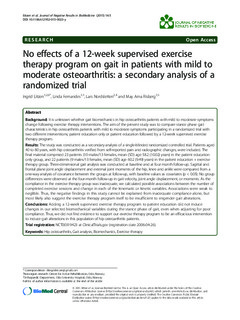| dc.contributor.author | Eitzen, Ingrid | |
| dc.contributor.author | Fernandes, Linda Maria | |
| dc.contributor.author | Nordsletten, Lars | |
| dc.contributor.author | Risberg, May Arna | |
| dc.date.accessioned | 2016-04-06T07:49:15Z | |
| dc.date.available | 2016-04-06T07:49:15Z | |
| dc.date.issued | 2015-03-05 | |
| dc.identifier.citation | Journal of Negative Results in BioMedicine . 2015, 14, 5 | nb_NO |
| dc.identifier.uri | http://hdl.handle.net/11250/2384126 | |
| dc.description | © Eitzen et al.; licensee BioMed Central. 2015.
This is an Open Access article distributed under the terms of the Creative Commons Attribution License (http://creativecommons.org/licenses/by/4.0), which permits unrestricted use, distribution, and reproduction in any medium, provided the original work is properly credited. The Creative Commons Public Domain Dedication waiver (http://creativecommons.org/publicdomain/zero/1.0/) applies to the data made available in this article, unless otherwise stated. | nb_NO |
| dc.description.abstract | Background: It is unknown whether gait biomechanics in hip osteoarthritis patients with mild to moderate symptoms
change following exercise therapy interventions. The aim of the present study was to compare stance phase gait
characteristics in hip osteoarthritis patients with mild to moderate symptoms participating in a randomized trial with
two different interventions; patient education only or patient education followed by a 12-week supervised exercise
therapy program.
Results: The study was conducted as a secondary analysis of a single-blinded randomized controlled trial. Patients aged
40 to 80 years, with hip osteoarthritis verified from self-reported pain and radiographic changes, were included. The
final material comprised 23 patients (10 males/13 females, mean (SD) age 58.2 (10.02) years) in the patient education
only group, and 22 patients (9 males/13 females, mean (SD) age 60.2 (9.49) years) in the patient education + exercise
therapy group. Three-dimensional gait analysis was conducted at baseline and at four month follow-up. Sagittal and
frontal plane joint angle displacement and external joint moments of the hip, knee and ankle were compared from a
one-way analysis of covariance between the groups at follow-up, with baseline values as covariates (p < 0.05). No group
differences were observed at the four-month follow-up in gait velocity, joint angle displacement, or moments. As the
compliance in the exercise therapy group was inadequate, we calculated possible associations between the number of
completed exercise sessions and change in each of the kinematic or kinetic variables. Associations were weak to
neglible. Thus, the negative findings in this study cannot be explained from inadequate compliance alone, but
most likely also suggest the exercise therapy program itself to be insufficient to engender gait alterations.
Conclusions: Adding a 12-week supervised exercise therapy program to patient education did not induce
changes in our selected biomechanical variables during the stance phase of gait, even when adjusting for poor
compliance. Thus, we did not find evidence to support our exercise therapy program to be an efficacious intervention
to induce gait alterations in this population of hip osteoarthritis patients.
Trial registration: NCT00319423 at ClinicalTrials.gov (registration date 2006-04-26). | nb_NO |
| dc.language.iso | eng | nb_NO |
| dc.publisher | BioMed Central | nb_NO |
| dc.subject | hip osteoarthritis | nb_NO |
| dc.subject | gait analysis | nb_NO |
| dc.subject | biomechanics | nb_NO |
| dc.subject | exercise therapy | nb_NO |
| dc.title | No effects of a 12-week supervised exercise therapy program on gait in patients with mild tomoderate osteoarthritis: a secondary analysis of a randomized trial | nb_NO |
| dc.type | Journal article | nb_NO |
| dc.type | Peer reviewed | nb_NO |
| dc.subject.nsi | VDP::Mathematics and natural science: 400 | nb_NO |
| dc.subject.nsi | VDP::Mathematics and natural science: 400::Basic biosciences: 470 | nb_NO |
| dc.subject.nsi | VDP::Medical disciplines: 700 | nb_NO |
| dc.subject.nsi | VDP::Medical disciplines: 700::Basic medical, dental and veterinary science disciplines: 710 | nb_NO |
| dc.source.journal | Journal of Negative Results in BioMedicine (JNRBM) | nb_NO |
| dc.identifier.doi | 10.1186/s12952-015-0023-y | |
| dc.description.localcode | Seksjon for idrettsmedisinske fag / Department of Sports Medicine | nb_NO |
